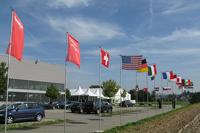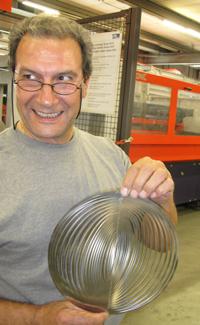Senior Editor
- FMA
- The Fabricator
- FABTECH
- Canadian Metalworking
Categories
- Additive Manufacturing
- Aluminum Welding
- Arc Welding
- Assembly and Joining
- Automation and Robotics
- Bending and Forming
- Consumables
- Cutting and Weld Prep
- Electric Vehicles
- En Español
- Finishing
- Hydroforming
- Laser Cutting
- Laser Welding
- Machining
- Manufacturing Software
- Materials Handling
- Metals/Materials
- Oxyfuel Cutting
- Plasma Cutting
- Power Tools
- Punching and Other Holemaking
- Roll Forming
- Safety
- Sawing
- Shearing
- Shop Management
- Testing and Measuring
- Tube and Pipe Fabrication
- Tube and Pipe Production
- Waterjet Cutting
Industry Directory
Webcasts
Podcasts
FAB 40
Advertise
Subscribe
Account Login
Search
Metal fabrication, the Swiss way
Swiss fabricators thrive amid an uncertain European economy
- By Tim Heston
- November 8, 2011
- Article
- Shop Management
Several years ago representatives from the Sultan of Oman approached Walter Maurer, president of Waterjet AG in Switzerland. They wanted a model of the sultan’s palace made out of sheet elements, trees and all. Each had to be of exotic, expensive material like gold and silver—no exceptions, even for interior parts hidden from view. For seven months Maurer’s 35-employee shop worked on the masterpiece, which ultimately cost the sultan 3.5 million Swiss francs (about $3.9 million).
In all likelihood, the sultan’s representatives called on Waterjet AG because of its reputation as one of the world’s largest contract fabricators dedicated to the abrasive waterjet. The company’s Aarwangen facility has 22 waterjets, including several five-axis systems and six microwaterjet machines capable of cutting small components requiring narrow kerfs and extreme accuracy. Another reason perhaps was Switzerland’s reputation for precision manufacturing boasting high technology and, most important, skilled people who operate and develop that technology.
In Waterjet AG’s lobby sits a replica of the sultan’s project, this one not of silver and gold but of more reasonably priced bronze, copper, and stainless steel (see Figure 1). It was built by an apprentice at Waterjet AG. The Swiss apprenticeship program helps prepare youth for the working world. They work about two days a week and attend school the remaining weekdays. The program helps students find their strengths and weaknesses, likes and dislikes.
According to a study from the Swiss-American Chamber of Commerce (SACC) and Booz & Co., a consultancy, the Swiss have enjoyed a renaissance in manufacturing in recent years, but the industry faces an all too familiar challenge: finding skilled people—a problem not foreign to U.S. fabricators. In Switzerland the problem just has a different twist.
As P.J. Hälg, CEO of Swiss manufacturer Dätwyler Holding AG, put it in the SACC report: “The strong core of well-educated and trained technical staff in Switzerland is a significant advantage for manufacturing in Switzerland. We are able to find highly capable and committed people, and this makes the difference. We just need more of them.”
In Switzerland you can window-shop for watches and bicycles that cost more than an American luxury sedan. The labor force isn’t cheap, nor is the cost of living, especially in sought-after regions. A hillside cottage facing Lake Geneva and the dramatic French Alps beyond may cost well more than a million Swiss francs. The franc also happens to be one of Europe’s strongest currencies.
Despite Switzerland’s costly labor, land, and currency, its manufacturing sector has remained about 20 percent of its GDP for more than two decades. SACC’s report put this in perspective: “This places Switzerland on par with or better than other major industrial powerhouses in terms of manufacturing’s contribution to GDP. In this regard, Switzerland is well ahead of the United States and the United Kingdom and about equal with Japan.”
Officially the country is called the Swiss Confederation, the Latin for which is Confoederatio Helvetica, hence the country’s CH abbreviation: CHF for Swiss franc, CH on license plates, CH as a Web address suffix, and so on. Famously neutral, the middle European state has no plans to join the European Union. The country has some of the earliest recorded examples of pure democracy after ancient Greece. The practice of Landsgemeinde, a town’s popular assembly, dates back to the 1200s. As Georg Thürer described in his history, Free and Swiss: The Story of Switzerland: “The people assembled in the open air on common land, standing in a great circle. Every member had the right to submit proposals and take part in the debate. The majority decided and the minority accepted the verdict.”
The confederation consists of cantons, like America’s states but, in the tradition of the Landsgemeinde, more independent, both in culture and language. Go west to Geneva and you hear French, east to Basel and Zurich you hear German; go south and you hear Italian; and climb up into the southwestern mountains, you may even hear Romansh, thought to be the closest living language to classic Latin.
Yet this mountainous, picture-postcard country of less than 8 million souls also happens to have a manufacturing sector respected the world over, and noteworthy enough to draw the Sultan of Oman’s eye.
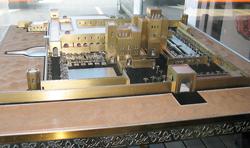
Figure 1: An apprentice at Waterjet AG worked on this copper, bronze, and stainless steel replica of the palace model the company made for the Sultan of Oman. Even the small palm trees are made of sheet metal. The original was made entirely of silver, gold, and other precious metals—and cost the sultan 3.5 million Swiss francs ($3.9 million).
From Glass to Metal
Before launching his waterjet shop Maurer worked for a manufacturer that operated glasscutting machines made by Bystronic. In 1988 Bystronic happened to complete its first prototype of a waterjet cutting machine, and soon after Maurer launched Waterjet AG. By September 1989 Maurer bought his first of many Bystronic abrasive waterjets.
His machine tool collection has ushered in an incredible variety of work: a large waterjet system screams as it pierces through steel nearly a foot thick; nearby a 3-D waterjet slices through previously formed aluminum plate, cut after bending because the kerfs are too close to the bend line (if the plate were cut first, it would deform during bending). A dozen meters away, in a quieter room, abrasive microwaterjet machines cut through a specialized ceramic that makes up the bottom of a watch face.
In September about 50 North American metal fabricators (and one FABRICATOR magazine reporter) witnessed all this as part of Bystronic’s 25th anniversary tour. The company was celebrating the opening of Bystronic Laser AG in 1986, when the organization erected its first building in Niederönz, a small town between Zurich and Bern. During the event the company unveiled several new products, including a waterjet cutting system and automation systems involving storage towers as well as part off-loading and sorting. The material handling systems (see Figure 2) are engineered to run faster than previous generations of the technology, sources said. As cutting lasers get faster—thanks to high-powered CO2 and fiber technology—so must automation.
When Bystronic Laser AG launched in 1986, many still identified it primarily as a glass industry player, and for good reason. The name comes from three business associates—Hans Byland, Paul Schneider, and Heinz Trosch—who in 1964 launched Bystronic Maschinen AG in the Swiss town of Bützberg, where they manufactured systems for cutting glass. In 1983 the company built its first laser cutting machine based partly on its glass cutting systems. These lasers happened to have a significant innovation for the day: flying optics.
Over the decades the company’s sheet metal machine tool business grew steadily in Niederönz. It entered the press brake arena after purchasing Hämmerle in 1997 and Beyeler in 2002—the same year the glass and metal fabrication machine tool operations officially split. As CEO Ferdi Töngi put it, “Since Bystronic sheet metal and glass had no common customers, and the requirements placed on products were different, a separation seemed the obvious course.”
The lion’s share of Bystronic’s revenue comes from exports, which is not surprising, considering you can drive across the company’s home market of Switzerland in a few hours (see Figure 3). But at home, many of its customers are what the Swiss call the KMUs, or klein und mittelunternehmugen: small and medium-sized enterprises.
So Much Dough
“KMUs make up the backbone of the Swiss economy,” said David Gibson, area sales manager for Rondo, a Swiss product line manufacturer that uses Bystronic equipment, including press brakes and laser cutting automation (see Figure 4 and Figure 5).
Rondo, itself a KMU, has 200 employees working in Burgdorf and about 400 employees worldwide. With annual sales of approximately 100 million CHF, Rondo makes dough-processing equipment. Pick up a treat from Dunkin’ Donuts, and it probably was shaped on a Rondo machine, some of which can process about 40,000 doughnuts an hour.
Rondo makes these large, custom lines in a Northern Italy plant, while its Burgdorf plant makes smaller systems. Many can be customized to some degree, but some machines do have standard options with demand consistent enough for make-to-stock manufacturing. The company’s showroom is a working bakery, with Rondo machines forming and feeding dough into baking equipment made by other companies. It is a sea of stainless steel (see Figure 6).
Still, Rondo doesn’t produce high volumes. This isn’t automotive manufacturing. By the laser cutting operations, Gibson pointed out a job packet and associated drawings showing various components that make up several dough-processing machines. It looked uncannily like a job packet from a typical sheet metal job shop.
“We try to optimize part placement,” Gibson explained. “This one order will take about 14 hours, and this [job packet] shows all the different parts we’re cutting for multiple machines.” He pointed to several large components that were to be nested on a single sheet. “For instance, these are safety guards we will use on four separate machines.”
As a sales manager, Gibson previously covered the Middle Eastern market, and he recounted stories of stiff competition from certain players flooding the market with cheap machines. A manual dough-processing machine from Rondo, called a “sheeter,” costs about 8,000 euros. A competing sheeter recently introduced in the Middle East cost the equivalent of 800 euros.
So how does this Swiss manufacturer compete? As Gibson put it, cheaper competitors really offer “consumable” machines that probably will need to be replaced at some point. Rondo machines, on the other hand, last a lifetime. Some of the world’s best pastry chefs learned on Rondo equipment. They’re familiar with the machines and know that they’re reliable, which is important. If a pastry company’s machine breaks, everything stops.
Gibson then pointed to a board showing youthful faces—the company’s apprentices. Like its machine tool supplier Bystronic, Rondo participates in the Swiss apprenticeship program (see Figure 7 and Figure 8). Youth between 16 and 20 go to school and for several years work at Rondo two days a week. Some choose a commercial track, which introduces students to front-office functions such as sales, purchasing, marketing, and accounting. Another track, dubbed “poly-mechanic,” introduces students to the various manufacturing operations and machine tools in use at Rondo, everything from lathes and automated machining centers to press brakes and laser cutting machines.
“These students work many different jobs,” Gibson explained. “They may spend time in assembly, then in our machining area, then in metal fabrication.” He added that after this four-year program, they can decide which areas they like and which they don’t. Most important, they leave school with highly sought after skills. “These kids have no trouble whatsoever finding a job,” he said.
Some apprentices stay on at Rondo after graduation, while others move on to different manufacturers. Managers know that they are training workers who may well one day work for competitors. But as sources explained, the apprenticeship program effectively helps train the next generation of Swiss workers whose talent makes the country’s manufacturers so highly regarded. They allow Gibson to sell a high-quality, 8,000-euro sheeter to customers who could have bought one for 800 euros.
As J. Tinggren, president of the Schindler Group, explained in the SACC report: “The majority of our revenues come from abroad, yet we continue to innovate and manufacture many of our products in Switzerland due to the outstanding base of engineering and technical talent here.”
Competing With Quick Response
This outstanding base doesn’t stop Pascal Michel from worrying about where he will find another qualified welder or machine operator. Michel is president of Michel Apparatebau AG, a sheet metal job shop in Herzogenbuchsee, one town over from Bystronic’s home base of Niederönz. The company was founded in 1991, and not long after Michel purchased one of the first high-frequency lasers Bystronic made.
Like its U.S. counterparts, Michel still has trouble finding qualified candidates. This isn’t because of anything wrong with the Swiss educational system—it’s just there aren’t enough Swiss to meet the demands of the country’s manufacturing sector.
The 30-employee shop has 11 towers that together hold 240 pallets, which feed material into three laser cutting centers. Such automation allows the company to respond to orders extremely quickly. Small orders—several dozen pieces or even fewer—make up a big part of Michel’s business, and the company can turn around most of them within a day (see Figure 9).
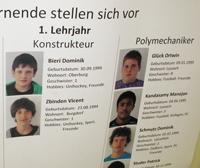
Figure 8: This board at Rondo shows the young people participating in the company’s apprenticeship program in all areas of the business, including the front office and the shop floor. The “Polymechaniker” apprentices, shown on the right, work with various machine tools in Rondo’s factory.
The plant uses PMC (Plant Manager Cutting) software, which communicates with the shop’s enterprise resource planning (ERP) software. As Frank Arteaga, Bystronic’s head of product management in North America, explained, “The PMC takes an ERP order and manages all the jobs in the factory. Say I want to run all the parts due within the next seven days. The software will nest them and automatically run all the jobs that meet a certain yield criteria.”
A user can set a certain level of material yield. So say he wants nested parts to use up at least 90 percent of a sheet. If a component is part of a job due within so many days, and if it fits within a nest that meets the material yield criteria, it will be automatically released. If the job can’t meet these criteria, the job scheduler can manually release the job.
Michel’s software infrastructure allows for the integration of both bending and cutting information. For example, suppose a press brake operator notices that a blank size doesn’t allow for the required bend deductions. In this case, he can immediately flag this error in the system, which communicates with a central database. From this the nesting software automatically renests the part using the correct blank size information.
A Customer Mix for Growth
Jürg Nyfeler is general manager of Fritz Born AG, a 35-employee contract fabricator in the Swiss town of Langenthal. The company has a precision sheet metal division and an operation serving the architectural and structural market, a sector that in Switzerland hasn’t suffered as dramatically as it has elsewhere. Active cranes still dot Swiss cityscapes. During the tour, Born’s structural department was busy. One worker ground and polished subcomponents for an aluminum frame that would eventually hold solar panels for residential roofs.
The shop still faces pricing pressure. Nyfeler pointed to his Hämmerle 3P 130-ton press brake, a system that offers three-point bending (see Figure 10). A center die component remains in contact with the outside radius throughout bending. Nyfeler then pointed to the company’s Bystronic laser cutting cell that can run unattended at night. As he explained, the day shift—which performs cutting, bending, welding, grinding, and polishing—essentially earns the shop enough money to keep the lights on and people employed. The unattended second shift produces the profits.
The shop’s bending and welding give the company a variety of services to offer and, hence, helps bring jobs in the door. Those customers then may give the company various work, some requiring just cutting, others calling for cutting, bending, and welding. This mix of jobs, Nyfeler said, keeps the company growing.
Skills Drive the Economy
For decades Morano Michele, the sheet metal shop supervisor at Rondo, hasn’t taken Swiss industry for granted (see Figure 11). In 1968 he lived with his mother near Naples, in an Italian region with high unemployment. His father, brothers, and sisters all had emigrated to Switzerland, and by the next year he and his mother did the same. In 1974 he landed a job at Rondo and never left. The 37-year veteran of Rondo’s sheet metal operation remembers the days of manual shearing and drilling. “Technology has moved on,” he said.
Michele is just what Swiss business leaders like to see: A skilled technician who moved from abroad to contribute his talents to the local economy. At the same time, business leaders are wary about the country’s continued growth, and much of the anxiety focuses on attracting talent.
Despite its reputation, Swiss manufacturers still are under relentless price pressures. The Swiss economy is a diamond in the middle of a tumultuous European economy. “For job shops in Switzerland, business is good,” said Bystronic’s Fred Weber, regional sales manager in Switzerland. “So many have work going through the roof.”
Many small job shops sell locally to Swiss manufacturers, but these medium-sized players—the KMUs—sell to the rest of Europe, and not all European economies are healthy, of course. So a downward pressure on price trickles down to the small Swiss job shop. “If job shops don’t cut prices, they fear they might lose the business,” Weber said.
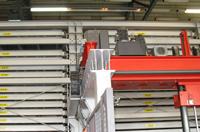
Figure 9: Michel Apparatebau AG has 11 towers that together hold 240 pallets, which feed material into three laser cutting centers.
Nevertheless, manufacturing still drives Swiss employment. Indeed, according to the SACC report, the Swiss manufacturing sector employed 699,000 in 2009. Meanwhile, the world-renowned Swiss banks employed only 144,000.
Businesses are anxious about the government’s view on immigration. Companies need more people like Rondo’s Morano Michele, and business leaders don’t want the Swiss government standing in their way. “There was clear anxiety about whether the Swiss government and the country as a whole will make the right choices on immigration and openness,” the SACC report said.
Some also have concerns about the strong Swiss franc, a challenge for a country that depends so heavily on exports. Still, in September the Swiss unemployment rate was only 2.8 percent—one of the lowest national rates in the world.
Swiss fabricators have invested in manufacturing technology to ensure quick turnaround of high-quality products. Some also have invested in the apprenticeship programs that feed Swiss manufacturers’ appetite for highly skilled employees. Although not perfect, the system has helped make the Swiss Confederation—with a land mass similar to Colorado’s—a manufacturing powerhouse that in 2009, according to the SACC, generated 99.2 billion CHF in value-added wealth (basically, revenue minus nonlabor input costs). That’s not bad for 699,000 workers in a recession year.
For metal fabricators and other manufacturers stateside—where finding skilled people remains a challenge, even during a time of high unemployment—the Swiss system may be worth a careful look.
About the Author

Tim Heston
2135 Point Blvd
Elgin, IL 60123
815-381-1314
Tim Heston, The Fabricator's senior editor, has covered the metal fabrication industry since 1998, starting his career at the American Welding Society's Welding Journal. Since then he has covered the full range of metal fabrication processes, from stamping, bending, and cutting to grinding and polishing. He joined The Fabricator's staff in October 2007.
Related Companies
subscribe now

The Fabricator is North America's leading magazine for the metal forming and fabricating industry. The magazine delivers the news, technical articles, and case histories that enable fabricators to do their jobs more efficiently. The Fabricator has served the industry since 1970.
start your free subscription- Stay connected from anywhere

Easily access valuable industry resources now with full access to the digital edition of The Fabricator.

Easily access valuable industry resources now with full access to the digital edition of The Welder.

Easily access valuable industry resources now with full access to the digital edition of The Tube and Pipe Journal.
- Podcasting
- Podcast:
- The Fabricator Podcast
- Published:
- 04/16/2024
- Running Time:
- 63:29
In this episode of The Fabricator Podcast, Caleb Chamberlain, co-founder and CEO of OSH Cut, discusses his company’s...
- Trending Articles
Steel industry reacts to Nucor’s new weekly published HRC price

How to set a press brake backgauge manually

Capturing, recording equipment inspection data for FMEA

Are two heads better than one in fiber laser cutting?

Hypertherm Associates implements Rapyuta Robotics AMRs in warehouse

- Industry Events
16th Annual Safety Conference
- April 30 - May 1, 2024
- Elgin,
Pipe and Tube Conference
- May 21 - 22, 2024
- Omaha, NE
World-Class Roll Forming Workshop
- June 5 - 6, 2024
- Louisville, KY
Advanced Laser Application Workshop
- June 25 - 27, 2024
- Novi, MI

























